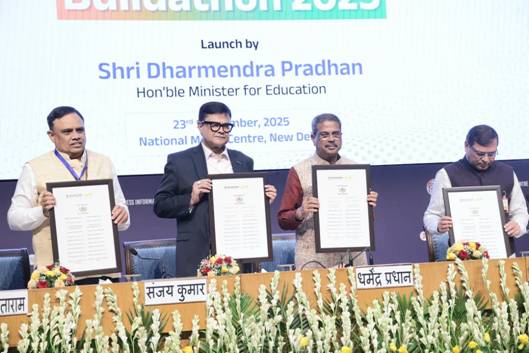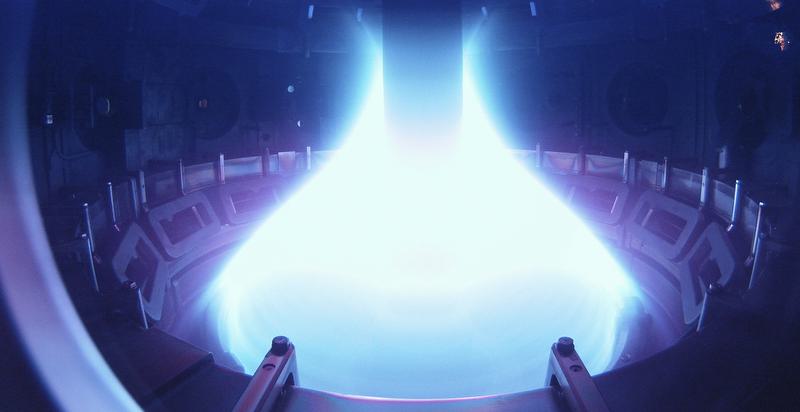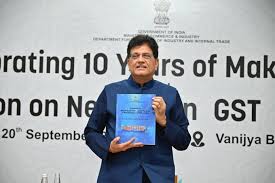Viksit Bharat Buildathon 2025

- 28 Sep 2025
In News:
- Union Education Minister Dharmendra Pradhan launched the Viksit Bharat Buildathon 2025, a nationwide school innovation movement aimed at nurturing creativity, entrepreneurship, and technological problem-solving among young students.
- The initiative seeks to transform school campuses into innovation hubs, empowering youth as the architects of a self-reliant and developed India.
About Viksit Bharat Buildathon 2025
- Organisers: Department of School Education and Literacy (DoSEL), Ministry of Education, in collaboration with Atal Innovation Mission (AIM), NITI Aayog, and the All India Council for Technical Education (AICTE).
- Culmination: January 2026, with felicitation of over 1,000 winners.
- Participants: School students across India — the largest school-level hackathon ever conducted.
Objectives
- Promote Grassroots Innovation: Cultivate a problem-solving mindset and creative thinking among school students.
- Foster Self-Reliance: Encourage innovation aligned with the principles of Atmanirbhar Bharat and Vocal for Local.
- Celebrate Swadeshi Innovation: Build indigenous solutions addressing real-world challenges.
- Enable National Development: Channel student ideas into tangible solutions for Samriddhi (prosperity) and Viksit Bharat (developed India).
- Create Global Impact: Project India as a global innovation capital and potential record-holder for the world’s largest synchronized innovation event.
Themes of the Buildathon
The competition revolves around four guiding themes that reflect India’s developmental vision:
- Vocal for Local – Promoting indigenous products and local entrepreneurship.
- Atmanirbhar Bharat – Encouraging technological self-reliance and innovation.
- Swadeshi – Leveraging traditional knowledge and indigenous technologies.
- Samriddhi – Designing solutions for inclusive and sustainable prosperity.
Structure and Timeline
|
Phase |
Timeline (2025–26) |
Key Activity |
|
Registration |
Sept 23 – Oct 6 |
Schools and students register via vbb.mic.gov.in |
|
Preparation Period |
Oct 6 – Oct 13 |
Teachers mentor student teams for ideation and submission |
|
Live Synchronized Innovation Event |
Oct 13 |
Nationwide simultaneous innovation challenge |
|
Final Submission Window |
Oct 13 – Oct 31 |
Upload of prototypes and project ideas |
|
Evaluation Phase |
Nov 1 – Dec 31 |
Expert panel assesses entries |
|
Grand Felicitation |
Jan 2026 |
Announcement of results and recognition of 1,000+ winners |
Building on Previous Success
The Buildathon builds upon the momentum of the School Innovation Marathon 2024, which led to:
- The Student Innovator Programme (SIP) and Student Entrepreneurship Programme (SEP).
- Multiple patents and startup ventures emerging from Atal Tinkering Labs (ATLs).
This continuum strengthens India’s school innovation ecosystem, linking student creativity to research, incubation, and entrepreneurship.
Significance
- Grassroots Empowerment: Encourages innovation at the school level, making every student a potential problem-solver.
- Integration with NEP 2020: Supports the National Education Policy’s emphasis on experiential learning, design thinking, and skill development.
- Atmanirbhar Bharat Vision: Aligns student innovation with national priorities of self-reliance and sustainable growth.
- Innovation Pipeline: Provides pathways for students to transition into formal innovation ecosystems — from idea to patent to startup.
- Global Positioning: Aims to showcase India’s youth-driven innovation capacity on international platforms.
India’s Fusion Energy Roadmap

- 28 Sep 2025
In News:
- Researchers at the Institute for Plasma Research (IPR), Gandhinagar, have unveiled a comprehensive roadmap for India’s fusion energy programme.
- This initiative aims to develop the country’s first fusion electricity generator, Steady-state Superconducting Tokamak–Bharat (SST-Bharat), and ultimately commission a demonstration reactor by 2060.
- The roadmap signifies a major step in India’s pursuit of sustainable, high-yield, and low-waste energy alternatives.
Understanding Nuclear Fusion
Nuclear fusion is the process where two light atomic nuclei (like isotopes of hydrogen) merge to form a heavier nucleus, releasing immense energy—similar to the reactions that power the Sun.
It differs from nuclear fission, where heavy atoms split apart to release energy.
Advantages of Fusion over Fission
- Minimal radioactive waste and no long-term storage challenges.
- Abundant fuel sources (deuterium from water, tritium from lithium).
- No greenhouse gas emissions and no meltdown risk.
- High energy density, offering a virtually limitless energy source.
India’s Current Fusion Research Base
- SST-1 Tokamak (IPR, Gandhinagar): India’s first steady-state superconducting tokamak, designed for plasma research. It has achieved plasma duration of ~650 milliseconds, with potential to reach 16 minutes.
- Participation in ITER (France): India contributes technology, components, and funding to the International Thermonuclear Experimental Reactor (ITER), the world’s largest magnetic confinement experiment aimed at demonstrating a Q-value (output/input ratio) of 10.
India’s Fusion Power Roadmap
1. The SST-Bharat Project
- A fusion-fission hybrid reactor proposed as India’s next major milestone.
- Expected output: 130 MW (100 MW from fission, 30 MW from fusion).
- Estimated cost: ?25,000 crore.
- Efficiency target: Five times the input power.
- Acts as a bridge technology toward achieving pure fusion energy.
2. Demonstration Reactor (By 2060)
- Planned 250 MW full-scale reactor.
- Target Q-value: 20 (i.e., producing 20 times more energy than input).
- Will use magnetic confinement, heating plasma to over 100 million°C — much hotter than the Sun’s core (15 million°C).
Technological Innovations Proposed
- Digital Twinning: Creating virtual replicas of tokamak systems to test and optimise operations before physical construction.
- Machine Learning-Assisted Plasma Control: Using AI for real-time monitoring and stability of plasma.
- Radiation-Resistant Materials: Essential for reactor longevity and safety.
- Superconducting Magnet Development: To maintain continuous plasma confinement efficiently.
Global Benchmarks and India’s Position
|
Country/Programme |
Reactor/Initiative |
Target Year |
Notable Achievement |
|
UK |
STEP Programme |
2040 |
Prototype fusion power plant planned |
|
USA |
Private Start-ups |
2030s |
Early grid-connected fusion target |
|
China |
EAST Tokamak |
Ongoing |
Record plasma duration |
|
France |
WEST Tokamak |
2025 |
Maintained plasma for 22 minutes |
|
India |
SST-Bharat & Demo Reactor |
2060 |
Gradual, state-led development path |
While global players pursue faster timelines, India’s approach is cautious but strategic, focused on self-reliance and steady technological progress.
Challenges in India’s Fusion Path
Technological
- Sustaining stable plasma for long durations.
- Achieving Q > 1 (self-sustaining fusion).
- Developing durable superconducting magnets and radiation-resistant materials.
Financial
- High costs: SST-Bharat alone costs ?25,000 crore.
- Competing priorities: Solar, wind, and fission projects receive higher funding.
- Limited private-sector participation compared to global trends.
Policy and Governance
- Absence of a dedicated fusion energy regulatory framework.
- Need for integrated policy support under India’s Net Zero 2070 commitments.
Economic Viability
Experts like M.V. Ramana (University of British Columbia) caution that commercial fusion power remains economically unproven, and timelines are often optimistic. High R&D and construction costs could make fusion electricity expensive compared to renewables.
Strategic and Technological Significance
Even if commercial viability takes time, fusion R&D brings collateral benefits:
- Advances in plasma physics, superconducting technology, and high-temperature materials.
- Development of radiation-hardened components for defence, space, and nuclear industries.
- Strengthened technological autonomy and enhanced participation in global research networks.
Impatiens Selvasinghii
- 28 Sep 2025
In News:
- In a significant botanical discovery, researchers from Madura College, Madurai, have identified a new species of flowering plant belonging to the genus Impatiens in the Kudremukh range of the Western Ghats, Karnataka.
- The species has been named Impatiens selvasinghii in honour of Dr. P. Selva Singh Richard, Associate Professor of Botany at Madras Christian College (MCC), for his pioneering contributions to the study of reproductive biology of endemic and endangered plants of the Western Ghats.
Key Details of the Discovery
- Location:Kudremukh Peak, Chikkamagaluru district, Karnataka
- Altitude: Approximately 1,630 metres above sea level
- Published in:Taiwania, an international peer-reviewed botanical journal
- Unique Features: The species is distinguished by its exceptionally small flowers—the smallest among known balsams of the Western Ghats—and prominently lobed wing petals.
- Ecological Role: Small insects are dependent on this species for survival, underscoring its role in the local micro-ecosystem.
The Genus Impatiens in India
- India hosts over 280 taxa of Impatiens, widely distributed across the Eastern Himalayas and the Western Ghats.
- About 210 taxa are endemic to India, with 130 species unique to the Western Ghats.
- Notably, around 80% of the Impatiens species in the Western Ghats are categorized as endangered, highlighting the region’s ecological vulnerability.
Conservation Concerns
Researchers have cautioned that Impatiens selvasinghii is located along a popular trekking route in Kudremukh, where over-tourism and habitat disturbance could threaten its survival. Given the fragile mountain ecosystem and high endemicity of balsam species, measures for habitat protection and responsible ecotourism are vital.
Clean Plant Programme (CPP)
- 28 Sep 2025
In News:
- The Clean Plant Programme (CPP), conceptualized by the Ministry of Agriculture and Farmers Welfare in collaboration with the Asian Development Bank (ADB), is emerging as a transformative initiative aimed at ensuring healthy, disease-free planting material of key fruit crops.
- Approved by the Union Cabinet, CPP is implemented by the National Horticulture Board (NHB) with technical guidance from the Indian Council of Agricultural Research (ICAR).
Background and Rationale
India faces growing challenges to plant health from climate change, pests, and systemic pathogens, especially viruses, which significantly reduce crop quantity, quality, and longevity. By the time disease symptoms manifest, management in the field becomes difficult and often ineffective. Providing disease-free planting material has therefore been recognized as the most efficient preventive strategy.
CPP aligns with broader initiatives such as Mission LiFE (Lifestyle for Environment) and the National One Health Mission, promoting sustainable, eco-friendly agriculture and integrated management of human, animal, and environmental health risks.
Key Features of CPP
- For Farmers: Ensures access to virus-free, high-quality planting material to improve yields, income, and resilience against climate-induced pest and disease pressures.
- For Nurseries: Streamlined certification, infrastructure support, and technical guidance help nurseries propagate clean material efficiently.
- For Consumers: Delivers superior-quality fruits free from viruses, enhancing taste, appearance, and nutritional value.
- For Exports: Strengthens India’s global position by promoting high-quality, disease-free fruits.
- Equity and Inclusivity: Facilitates affordable access for all farmers, engages women in training and decision-making, and develops region-specific varieties for India’s diverse agro-climatic zones.
Investment and Implementation
CPP represents an investment of ?1,765.67 crore, including an ADB loan of $98 million. Key developments include:
- Nine Clean Plant Centres across India, including three in Maharashtra for grapes (Pune), oranges (Nagpur), and pomegranates (Solapur).
- Financial support for nurseries: ?3 crore for large nurseries and ?1.5 crore for medium nurseries. Expected annual production of 8 crore disease-free seedlings.
- Establishment of a national-level research laboratory in Pune for original plant species research.
- International collaboration with countries such as Israel and the Netherlands.
On-Ground Actions and Progress
- Hazard Analysis (HA): Virus profiling for grapevine, apple, and citrus crops, forming the foundation for Clean Plant Centers and certification.
- Nursery and Lab Assessments: NHB, ICAR, and ADB teams evaluated nurseries and laboratories across states for readiness, infrastructure, and bioinformatics capability.
- Clean Plant Propagation: Material testing, virus elimination through tissue culture, heat, or cryotherapy, and distribution through accredited nurseries to farmers.
- Digital and Resource Platforms: CPP website serves as a central hub for updates, resources, and technical guidance.
Alignment with Other Initiatives
- Mission LiFE: Encourages sustainable environmental practices and individual/community-level action to conserve natural resources.
- National One Health Mission: Integrates human, animal, and environmental health to manage disease risks and improve productivity.
- Mission for Integrated Development of Horticulture (MIDH): CPP complements MIDH’s goals of providing quality planting material and micro-irrigation to enhance horticultural productivity, which has increased from 12.10 MT/ha (2019–20) to 12.56 MT/ha (2024–25, 2nd advance estimates).
Industrial Park Rating System 3.0

- 28 Sep 2025
In News:
- Recently, the Union Minister of Commerce and Industry, Shri Piyush Goyal, launched the Industrial Park Rating System (IPRS) 3.0 in New Delhi as part of the decade-long celebrations of the Make in India initiative.
- Developed by the Department for Promotion of Industry and Internal Trade (DPIIT) with support from the Asian Development Bank (ADB), IPRS 3.0 aims to benchmark and enhance the competitiveness of industrial parks across India.
Background and Evolution
The IPRS initiative began in 2018 as a pilot project, followed by IPRS 2.0 in 2021. The third edition builds upon these earlier versions by introducing a more comprehensive framework to assess industrial infrastructure, operational efficiency, and overall competitiveness.
Features of IPRS 3.0
IPRS 3.0 evaluates industrial parks based on multiple parameters, including:
- Sustainability and green infrastructure
- Logistics connectivity
- Digitalization
- Skill linkages
- Tenant feedback
Based on performance across these indicators, industrial parks are categorized into Leaders, Challengers, and Aspirers. This benchmarking enables stakeholders, including investors and policymakers, to access reliable and transparent data, identify best practices, and implement targeted interventions.
Significance for Industrial Development
The launch of IPRS 3.0 aligns with India’s broader strategy to create world-class industrial infrastructure. It provides States and Union Territories with an opportunity to:
- Showcase high-performing industrial parks
- Identify gaps for infrastructure improvement
- Attract domestic and foreign investments
- Generate employment
- Strengthen their industrial ecosystem
